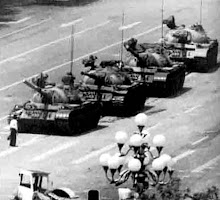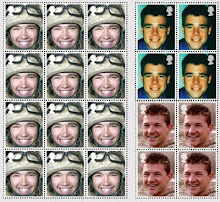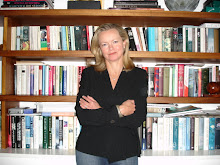
My Dad - 12/06/23-18/12/08 - Requiescat
The rumours are, I am afraid, all true. I was once an avid collector of autographs. Long, long before these our days of celebrity culture, I was an over-keen, gangly pre-teen, hanging around the stage door, never without my leather-backed notebook and lucky ball-point pen. I can still see the first three pages with their hurried yet clearly legible marks: Cliff Richard; Frankie Vaughan; Gilbert O’Sullivan!!!
The notebook is long gone, of course. Into some trunk, into some attic, gnawed on by rodents or consumed on some bonfire. I still have a few prized signatures, however; many of them just visible in the corners of the paintings & lithographs I started to collect when autographs per se started to pall. I’ve even got the Queen. Her bold Elizabeth R, in a rather beautiful frame, hangs on the wall above the sink (signed Philippe Starck) in our downstairs WC.
I didn’t actually wangle an invite to Buckingham Palace and whip out a scrap of paper and a fountain pen at a likely juncture. I didn’t need to. Her Majesty made her mark upon the royal warrant conferring the Imperial Service Order upon my father – making him Fred Jackson, ISO, QFSM, CPM. Every time I wash my hands, I now have a mental picture of the Queen, perched at a huge desk in Sandringham or Balmoral, spectacles on, looking as serious as Helen Mirren in that movie, working her way through a ream of parchment warrants, scratching out Elizabeth R again & again & again.
The ISO was established in 1902 by Edward VII. It is a limited order, awarded to a select group of civil servants “for long and meritorious service of the British Empire”. It was seriously limited in 1993, when it was quietly dropped in favour of the Imperial Service Medal; stands to reason – we haven’t really got an Empire any more.
Dad himself was quietly but hugely proud, not just of his ISO, but of his many awards. Myself, I was proudest when I went, in my Sunday best, to Government House to see Sir David Trench present Dad with The Governor of Hong Kong Lanyard – awarded for outstanding gallantry during the 1967 Communist uprising and riots. Self-effacing, modest & often surprisingly shy, the most he would ever say was: “not that bad for a boy from Askern, is it?”

A few years ago, Dad started to write his own memoirs. Alas, they stop abruptly in 1968 – when my mother, Tina, was first diagnosed with breast cancer. He has a charming, candid and quietly comic voice and I hope to do something with them at some stage. For now, I am afraid, the following will have to temporarily suffice:

Fred was born in 1923 in a tiny hamlet on the edge of the South Yorkshire coalfield. My grandfather, Cecil, was still a dairyman then but the pit at Askern would soon dominate the local economy. My grandmother, Violet, née Spink, went on to have another 10 children: Sidney; Charles, William Arthur; Anne Cecilia; Eric; Cecil; Stuart; Violet; Michael and Norma – the latter and her brother Eric both died as infants of pneumonia. At time of writing, both of Dad’s sisters and his brothers Bill and Michael survive him.
My grandfather went on to tend to the pit ponies and Dad’s bi-annual trip underground to bring them out for their brief respite in the fresh air convinced him that a miner’s life was not for him. Despite fierce paternal opposition, he escaped the pit by joining the Navy and swiftly, despite a truncated formal education, became a commissioned officer.

In 1944, he found himself accompanying the Canadian tanks across to Juno Beach on D-Day & celebrated his 21st birthday, not as I did, with champagne and canapés under an elegant 18th century colonnade, but on a battered landing craft, negotiating the choppy Channel waters on his way back to England. My mother clearly fell for this wind-burnished chap in uniform and they were married in October 1946.

Dad then joined the Fire Brigade in Doncaster and in 1956, he and my mother left for an initial three year contract in Hong Kong, a move rather braver than any gap year student with a mobile phone and laptop might now be able to fully comprehend.

My parents both loved the colonial lifestyle and tropical weather and my father endeared himself to his men by learning to speak fluent Cantonese (albeit retaining his distinctive Yorkshire accent). Dad was an exemplary officer and was decorated several times for gallantry. He was instrumental in preparing HKFS for the eventual localisation of senior ranks ahead of the 1997 handover and, by the time he retired in 1985, he was the Deputy Director of the Brigade.
Alas, in 1975, we lost my mother, Tina, to breast cancer and were doubly devastated less than 20 years later when my brother Rory became an early and ludicrously young victim of HIV/Aids. Dad himself enjoyed nearly 20 years of healthy retirement back home in Yorkshire until 2006, when on-going heart and vascular problems prompted his cardiologist to give him a pacemaker. This operation coincided with a diagnosis of a fairly rare condition: Dementia with Lewy Bodies, which, although not yet fully understood, seems to combine the worst elements of both Parkinsons and Alzheimers.
Difficult as it is to watch someone you love & who was once so very vital, thus cruelly diminished, I found it comforting that Dad’s vivid hallucinations – a key symptom of DLB – usually took him back to Hong Kong or to his Navy days and that very often he clearly saw my late brother, Rory, sitting amiably at the foot of his bed.
Otherwise, Dad’s final months were not as dignified as I, or anyone who loved him, would have wished and I intend to write elsewhere about the terrible circumstances of his demise – when the time is appropriate. Certainly not until after we hold our service of Thanksgiving for & Celebration of his life on Friday 8th May, at St Joseph’s Church in Pontefract, where my parents were married, after which his ashes will be interred in my mother’s grave, alongside Rory’s.
Dad wanted any donations in his memory to go to the Fire Fighters Charity or to the Mission to Seafarers. You can find out more, both about the charities and about Fred on our justgiving.com page.







